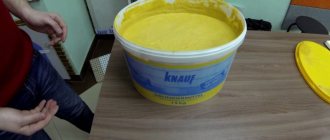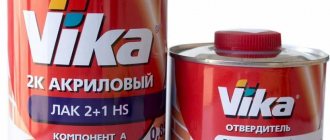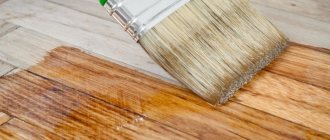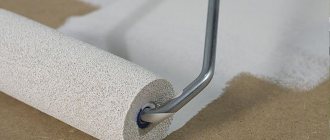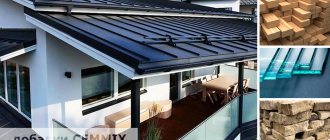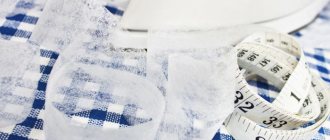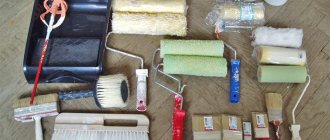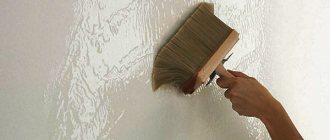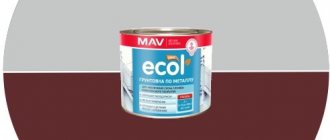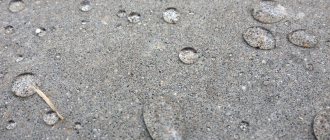When the main construction work is completed, the walls are perfectly smooth. Now you can start painting the walls, but before painting the walls must be treated with a special primer solution. Many people neglect this, which can subsequently affect the quality of the paintwork and its durability.
A primer for walls for painting is a liquid of a special chemical composition (various pigments, resins and oils, adhesives) that must be applied to the surface of the walls before painting. The main purpose of the primer is to create a special layer that will ensure reliable adhesion of the surface to the paint. After treating the walls with a primer, the paint adheres to them better, and durability increases.
After applying a layer of primer, it is reliably and deeply absorbed into the surface and forms a high-strength bond. The adhesive properties of the surface are increased, which makes it possible to apply any paints and finishing materials to the wall. The primer also prevents the absorption of moisture from the finishing material when applied to the surface of the walls.
Acrylic primer - what is it and what is it for?
Acrylic primer is a material used on a base prepared for cladding or painting. Many people are interested in what acrylic primer is needed for? Using a primer, you can achieve excellent adhesion of the base to the new coating. In addition, proper surface treatment will protect the wood from fungi and rot, and the metal from corrosive destruction.
Acrylic primer is a material used on a base prepared for cladding or painting.
Advantages of compositions containing acrylic
The main advantage of acrylic primers is their versatility, the ability to prepare the base for finishing with paint or putty, and make the surface of various types more durable. The soil is resistant to mechanical and external influences, moisture resistant.
Another advantage of this product is environmental safety. Safety is ensured by the composition of the product, which is a water-based mixture with a small amount of solvent. This way, you can prime the interior of your home because the mixture is odorless. However, it should be borne in mind that solvent-soluble mixtures are used only for facade work, as they are toxic.
The soil is resistant to mechanical and external influences, moisture resistant.
Story
Acrylic paints are considered a fairly modern material, as they were first produced in Germany in the late 20s of the last century. The history of the invention of acrylic paints has several stages.
First, oil nitrocelluloses were obtained. They are considered the first synthetic paints. In New York, such paints were used in the automobile industry and in construction.
At the next stage, polyvinyl acetate was obtained, which contained alkyd masonry for buildings.
The ability to work with resins, as well as the ability to dilute them with organic solvents, became the starting point for the invention of acrylic paints.
The first paints were released in 1947 under the Magna brand. They were polyacrylic dissolved with turpentine. Water-soluble emulsions appeared only a few years later.
This was a breakthrough of sorts. The paint, which was distinguished by a high degree of brightness and also did not require a complex solvent, gained extraordinary popularity. It spread with great speed, so artists from different countries soon began to be interested in the possibilities of new paints.
The technique of working with acrylic has become almost the main one in modern painting since the mid-20th century. World-famous pioneers were such artists as Mark Rothko, Alan Charlton, Andy Warhol, Bridget Riley, Richard Estes and David Hockney.
What to look for when buying acrylic primer
In the process of repair and finishing work, a high result becomes achievable if you choose the right primer. When purchasing a mixture, you need to consider the following factors:
- Type of base. A universal acrylic primer can be used for dissimilar surfaces, and homogeneous brick, concrete, and wooden surfaces require mixtures specially designed for these materials;
- Type of coverage. Each type of material, regardless of plastic or ceramics, glass or plaster, plaster or paint product, needs to select its own primer. Typically, manufacturers indicate on the packaging what kind of coating a particular primer is suitable for. However, if you plan to use colorless varnish as a coating, then you need to take into account the color of the mixture, but the walls on which there will be wallpaper do not require this;
- Economical. Due to the fact that the acrylic primer contains water, its consumption is minimal, except for resin-based compositions;
- Environmental friendliness. This characteristic allows the soil to be used in interior work;
- Drying time. Products based on latex or water are quick-drying;
- Quality. GOST will allow you to avoid purchasing low-quality products;
- Release form. Primers are sold both in the form of a concentrated and ready-made solution, as well as in the form of aerosols.
Products based on latex or water are fast-drying.
Specifications
Its composition has a huge impact on the technical characteristics and further use of the mixture. However, despite the different ratios and sizes of ingredients, the general characteristics are preserved, these include:
- Adhesion;
- Antiseptic properties;
- Moisture resistance;
- Resistance to mechanical and chemical influences;
- Strengthening the foundation;
- Vapor permeability;
- Saving.
Compound:
- Main components;
- Organic or water based;
- Dyes (usually white, less often black);
- Adhesive particles;
- Hydrophobic elements;
- Antibacterial components;
- Anti-mold additives;
- Resins, oils and bitumens;
- Copolymers and polymers;
- Insulators.
Its composition has a huge impact on the technical characteristics and further use of the mixture.
Thinning paints
The pigment of acrylic paints is small particles that are found in the binder component. The plastic mass in its raw form resembles milk, and after hardening it becomes transparent.
As long as the acrylic has not undergone a polymerization reaction, it is highly soluble in water. Water is used not only for dilution. Use it to wash the palette and brushes after finishing work. But acrylic paints, unlike other types of paints, become insoluble after drying. On the one hand, this is a significant disadvantage, since it is impossible to wash off dried paints.
However, most artists consider this quality as an undeniable advantage.
Layers of paint do not allow water to pass through, and the finished work is not susceptible to exposure to moisture. In addition, new layers can be applied over the dried layer of paint. If you wash your brushes well after each job, they will last a long time. If you are only careless about cleaning your brushes a couple of times, they will immediately become damaged. Particles of paint get clogged between the hairs of the bun, as a result of which the bun loses its former shape.
Not only water can be used as a diluent. Most acrylic paint manufacturers offer their own liquids that change the consistency of the polymer.
The so-called glossy and matte thinners deserve special attention.
Gloss thinner improves the covering properties of the paint. After hardening, a characteristic shine forms on the surface. Matte thinners, on the contrary, create matte surfaces.
What types of primers are there with acrylic?
Primers can be classified depending on their composition and application.
By purpose
Classification of acrylic-based primer:
- An acrylic-based deep penetration primer is a product that can penetrate deeper than 100 mm into the substrate. This type of acrylic primer has a positive effect on the quality and durability of the finish and reduces composition consumption;
- Adhesive primer is a mixture containing quartz fillers. The product is used for non-absorbent or weakly absorbent substrates, for example, glass, tiles, plastic. Often this primer is colored;
- Impregnation is applied on an unevenly absorbent surface;
- The strengthening primer has the properties of filling the pores of the surface, cementing it;
- The universal primer is multifunctional and is suitable for all types of surfaces, but it is not as effective as all other types of solution separately;
- Acrylic product for wall surfaces has anti-corrosion and antiseptic properties. It is a light-resistant and color-fast solution.
A deep penetration primer has a positive effect on the quality and durability of the finish and reduces composition consumption.
By type of solvent
Acrylic primer can be classified by solvent type.
Water soluble
An acrylic water-based primer is designed to level and strengthen the absorbent surface; it is environmentally friendly and non-toxic for indoor use.
Water-based acrylic primer is designed to level and strengthen the absorbent surface.
Organosoluble
The resin-based mixture performs protective functions, preventing the development of fungi, its consumption is minimal. Used as facade treatment.
The resin-based mixture performs protective functions, preventing the development of fungi, its consumption is minimal.
Depending on the surface to be coated
When choosing a primer solution, it is necessary to take into account, in addition to all the listed factors, the type of base.
When choosing a primer solution, it is necessary to take into account the type of base.
Deep
Suitable for absorbent brick substrates or surfaces made of foam concrete, cement, and gypsum. This type of impregnation guarantees good adhesion, vapor permeability, and is environmentally friendly and safe. Can be used before installing tiles, painting, or wallpapering. It strengthens loose and friable bases and is used for interior decoration and façade treatment.
Suitable for absorbent brick substrates or surfaces made of foam concrete, cement, and gypsum.
Adhesive
Acrylic primer is intended for non-absorbent concrete surfaces, before plastering or applying gypsum or limestone-gypsum mixtures. It is used as a treatment agent for oil and alkyd surfaces.
It is used as a treatment agent for oil and alkyd surfaces.
Water-dispersed
One-component compositions are intended for processing wood and OSB. The product allows you to add colored tints to it.
One-component compositions are intended for processing wood and OSB.
For wood and metal
For metal surfaces, an anti-corrosion primer based on resins and water with anti-corrosion components is used. This product is designed to protect metal with a water-repellent film. It is used both before painting and as the last layer.
For metal surfaces, an anti-corrosion primer based on resins and water with anti-corrosion components is used.
The ideal solution for a wooden surface would be to paint it with a special primer. It will protect the base from mold, rot and pests thanks to its antiseptic and antibacterial properties. In addition, a special product will improve adhesion to the coating and increase strength.
The primer will protect the base from mold, rot and pests due to its antiseptic and antibacterial properties.
Preparing a painted surface for painting
How to prepare and prime a previously painted wall or ceiling with your own hands?
The instructions are approximately the same for all types of soil.
- The peeling areas of the coating are removed with a spatula.
- The surface is sanded with coarse sandpaper or a sanding grid of numbers 80-100. It is acceptable to use a wire brush or a suitable attachment for a hand-held power tool. The goal is to leave as many small scratches on the coating as possible to promote primer adhesion.
Please note: it is better not to neglect this operation even if the manufacturer assures that grinding can be done without. A glossy surface always provides poorer adhesion to the next coating.
- Irregularities remaining from peeling paint are filled with putty compatible with the base (concrete, wood, etc.).
Puttying areas with peeling paint.
- The putty areas are sanded again.
- The primer is applied with a brush or roller. A spray gun is not suitable in this case: all the primers we examined have a consistency that is too thick for pneumatic spraying.
How to prepare acrylic primer yourself
It is possible to prime the surface yourself; you do not need special equipment for this. All you need is a roller, a couple of brushes, one wide and the other narrow, a container for primer and gloves.
First, the mixture is poured into a plastic bowl and the roller needs to be immersed 1/3 of the way into it so that the liquid does not drain from it. Then the primer is applied to the surface with a roller. Since the solution has the ability to penetrate deeply, a little of it will be required. It is better to work in hard-to-reach areas and in corners with a brush; streaks can also be removed with a brush. Apply 2 layers, the second only after the first has completely dried.
Apply 2 layers, the second only after the first has completely dried.
Color range of acrylic mixtures
Nowadays there are a lot of different products for tinting building mixtures on sale. The choice of colors depends on what the finishing will be.
You can do the tinting yourself, it’s not particularly difficult.
Nowadays there are a lot of different products for tinting building mixtures on sale.
Specifications
The scope of application, operating conditions and service life of the starting layer depend on the characteristics of acrylic primers and technical quality indicators.
Drying time for universal, adhesive and protective primer is from 30 minutes to 4 hours, for deep penetration the time increases to 6 hours. Work on applying the finishing touch can be continued after a day, provided that the air temperature is not lower than +200 C.
- The minimum curing temperature of the layer for external and internal work is +50 C, the maximum is +400 C.
- The penetration depth depends on the porosity of the base and ranges from 0.5 mm to 10 mm.
- The coating is not frost-resistant, the operating temperature range of the protective film is from -400, maximum temperature is +600 C.
- The viscosity of the mixture is 40-42 Pa s, the density of the dried film is 1.00 -1.03 g/cm³, the application consumption is from 60 to 120 g/m2.
The emulsion does not contain toxic substances, does not require personal protective equipment when working, and does not release harmful components into the air.
Features of using acrylic primer
When priming, experts advise:
- Do not use different types of primers on the same substrate;
- It is better to treat corners, joints and raised areas with a brush;
- On a flat surface it is better to use a roller;
- When using an aerosol, use a construction mask and goggles;
- The second layer is applied only after the first has completely dried;
- When choosing a primer, consider the type of base and type of material.
On a flat surface it is better to use a roller.
The use of an acrylic primer before finishing work significantly improves the final result and minimizes the cost of finishing materials. However, the most important thing is to follow the manufacturer's recommendations.
Coating Tools
For any successful construction process, including work using acrylic paints, it is necessary to use high-quality tools. To paint a room or furniture quickly and smoothly, you need the following tools:
- Brushes of different sizes: they will be used to paint hard-to-reach areas, corners, or for painting, including on wood.
- Rollers with short and long handles (the latter is necessary when painting the ceiling, but it can be replaced by purchasing a removable telescopic handle), the pile of which should be of medium length.
- Painting bucket (you can save money and use a regular one, but specialized equipment includes a mesh for cleaning the roller from excess paint, which should not be applied to the surface).
- Set of spatulas of various widths.
- Wide film.
- Masking tape for sealing joints and sockets.
This set of tools can be called basic, and you need to take care of its availability in advance before you start applying paint.
List of basic painting tools
For a more technological process, additionally purchase a tray, textured attachments for rollers, a roller with a bendable piece of iron, and in rooms with a high ceiling you will additionally need a ladder.

